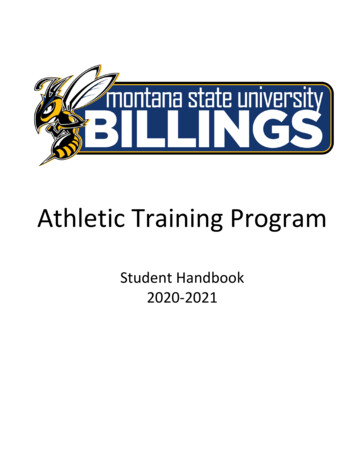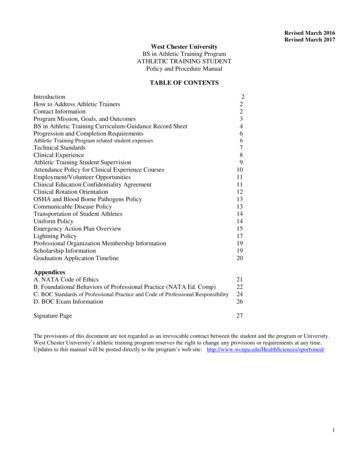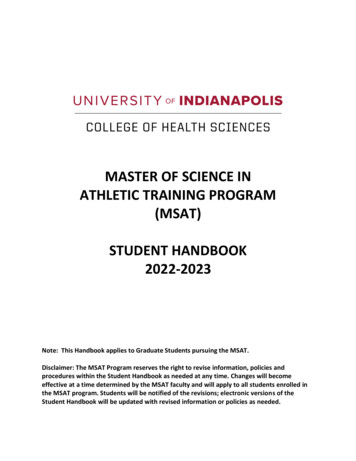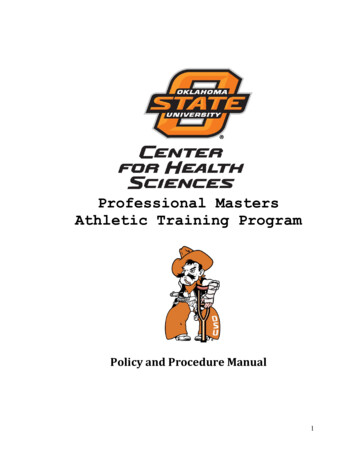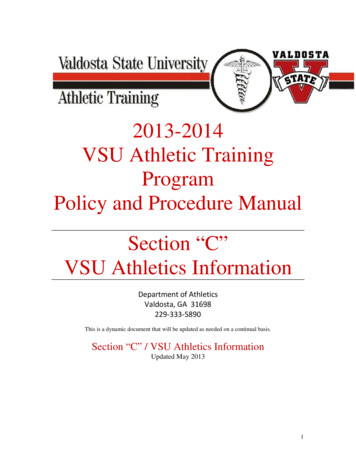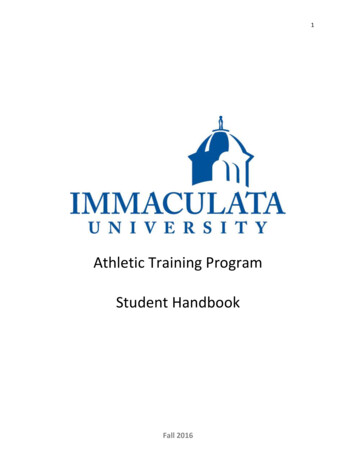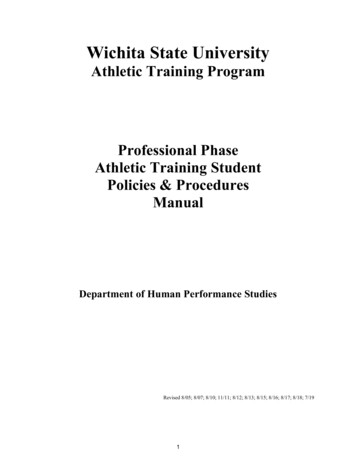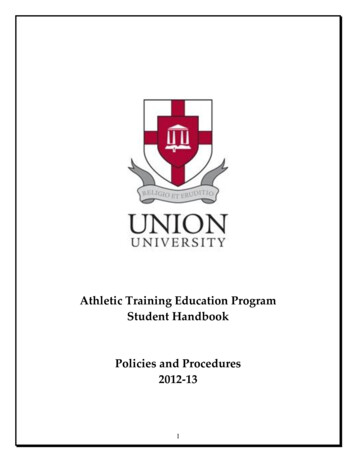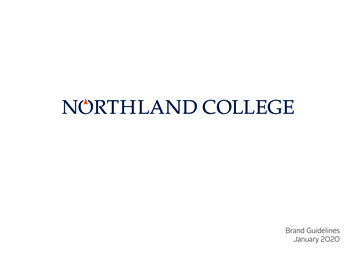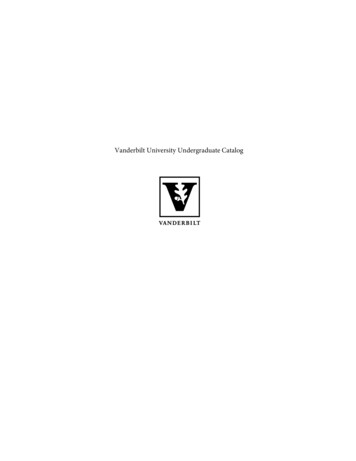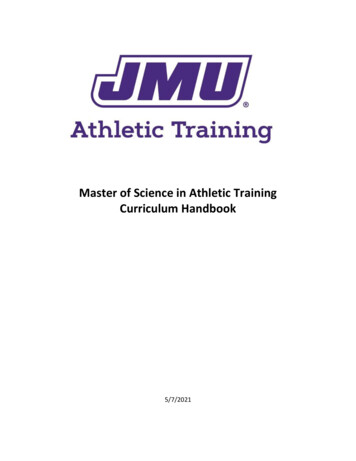
Transcription
Master of Science in Athletic TrainingCurriculum Handbook5/7/2021
Table of ContentsSection I: Program InformationVision StatementMission StatementGoals and OutcomesNon-Discrimination StatementDefinition of TermsUse of Athletic Training Professional Terminology4444567Section II: Curriculum AspectsPre-Professional PhaseAdmission Process/Admission RequirementsCompetitive and Selective ProgramAT Program Admission ProcessNotification of AcceptancePotential Additional Requirements Once Admitted to the AT ProgramOnce Accepted into the Athletic Training ProgramFeesAnnual RequirementsOrientationCourse SequenceSimulation RequirementsProfessional ConductClassroom Conduct ExpectationsRetention RequirementsDisciplinary ActionAcademic Warning and DismissalAcademic WarningDishonestyAppeal / Grievance ProcessGraduation tion III: Clinical AspectsClinical Education Experience/RequirementsBeginning Clinical AssignmentAbsence from Clinical SettingOutside of the Semester Requirements1717191919
Outside Employment and Athletic TrainingFinancial AssistanceConduct with Patients/AthletesDating/Fraternizing with Patients/AthletesDating/Fraternizing with AT Graduate Assistants or StaffTravel with teamsGeneral Professional Tobacco policyAlcohol and Drug PolicyCell Phone UseSocial MediaDress CodeIdentificationOff-duty AttireDirect Supervision PolicyClinical Education Experiences DocumentationConfidentiality of RecordsEquipment IssueCommunicable Disease PolicyBloodborne Pathogen Exposure Policy OverviewHealth Insurance Portability & Accountability Act (HIPAA) TrainingFamily Educational Rights & Privacy Act (FERPA) TrainingDismissal From Clinical SiteSection IV: FormsGuidelines for Technical Standards for Entry-Level Athletic Training ProgramTechnical Standards Verification StatementAthletic Training Student’s Commitment to ExcellencePatient Confidentiality FormOSHA Exposure to Bloodborne 6272727282833343536
Section I: Program InformationVision StatementTo be a national leader in Athletic Training EducationMission StatementJames Madison University’s Athletic Training Program provides challenging and progressiveacademic and clinical educational experiences to prepare students to be leading professionalsin the community of Athletic Training.Goals and OutcomesGoal 1: Students will demonstrate knowledge, skills, and behaviors of entry-level athletic trainersprepared for professional practice according to the BOC Practice Analysis 7th Edition.Student Learning Outcomes:SLO 1.1 - Students will earn a B- or better on all AT courses.SLO 1.2 - Students will be rated 80% or better on their clinical proficiency skills each semester.SLO 1.3 - Students will earn an 80% or better on all practical exam assessments (e.g. practicals,standardized patient cases, OSCEs, etc.) within two attempts each semester.SLO 1.4a - Students will earn a “Level 3” rating on 100% of their clinical skills milestoneevaluations by graduation.SLO 1.4b - Students will earn a “Level 3” rating on 100% of their foundational behaviorsmilestone evaluations by graduation.SLO 1.5 - Students will demonstrate the ability to provide quality documentation suitable topursue reimbursement.SLO 1.6 - Students will rate themselves as confident on each ACES Self-Reporting Assessmentcompetency.SLO 1.7 - 100% of students will pass the BOC Exam on their first attempt following completionof the program.SLO 1.8 – After taking the BOC Exam, the majority of students will rate themselves as preparedor well prepared on the BOC Preparedness Survey.Goal 2: To provide dedicated and qualified professionals who provide a quality learning environment.[Faculty evaluations, preceptor evaluations, program report]4
Program Outcomes:2.1 Faculty will earn an average rating of 4 or better on their mean faculty evaluation score.2.2 Preceptors will earn an average rating of 4 or above on each criterion on their preceptorevaluations averaged over the year.2.3 Clinical sites will earn a recommendation for continued use for clinical education byproviding frequent learning opportunities (3 or above) and routinely followingappropriate policies (e.g. OSHA, NCAA, EAPs, etc.).Goal 3: To be faculty role models to students who demonstrate a contribution to the advancement ofthe profession through scholarly activity or service.Program Outcomes:3.1 Faculty will meet scholarship and service goals annually as determined with AUH on theirFaculty Anticipated Activity Plan.3.2 Faculty will lead preceptor training and continuing education to advance professional skillsand mentoring abilities of our preceptors that earns an above average rating on thepost-workshop survey.Goal 4: To provide a quality education that prepares students for transition to practice.Program Outcomes:4.1 The majority of students report feeling prepared or well prepared on all items in the alumnisurvey.4.2 The program will work to define the key factors that significantly influence team learning andperformance when working in interprofessional health care teams in order to develop aninterprofessional education assessment tool.4.3 The program will determine how to intentionally infuse simulations/SPs across thecurriculum to facilitate and assess critical decision making.Non-Discrimination StatementJames Madison University does not discriminate on the basis of race, color, national origin, religion,gender, age, veteran status, political affiliation, sexual orientation or disability. The AT Program alsodoes not discriminate on any of the above bases, however, enrollment in the AT Program does require5
the ability of the student to meet the Technical Standards for the duration of the program (seeTechnical Standards section of the Handbook).Definition of TermsPreceptor - A certified/licensed professional who teaches and evaluates students in a clinical settingusing an actual patient base.Athletic Training Student (ATS) - A student formally enrolled in the professional phase of the athletictraining curriculum.Clinical Education – The application of athletic training knowledge, skills, and clinical abilities on anactual patient base that is evaluated and feedback provided by a preceptor. Entry-level AthleticTraining Clinical Proficiencies under the direct supervision of a preceptor. Clinical education may occurin a minimum period of two academic years (4 semesters) and be associated with course credit.Direct Supervision – Direct supervision refers to the close monitoring of the athletic training studentduring the clinical experience. The preceptor must be physically present and have the ability tointervene on behalf of the athletic training student and the patient. Only clinical hours that occurunder the direct supervision of a preceptor are recognized by CAATE and JMU’s Athletic TrainingProgram. Radio or cell phone contact does not constitute direct supervision and is an infraction ofJMU’s clinical policies.Clinical Education Requirements - Students must complete a variety of clinical experiences thatincorporate different populations including genders, protective equipment (to minimally includehelmets and shoulder pads), non-sport populations, and medical experiences that address thecontinuum of care that would prepare a student to function in a variety of settings and meet thedomains of practice delineated for a certified athletic trainer in the profession. (For informationspecific to JMU’s clinical requirements, see Clinical Education Requirements).Clinical Setting: A clinical setting is a clinical environment where health care services are provided. Theclinical setting shall include the athletic training facility, athletic practices, competitive events,physician’s clinics, physical therapy clinics, hospital emergency rooms, and various allied health caresettings. The student must be supervised by an appropriate preceptor while in these settings.Educational Competencies: The Educational Competencies are the individual cognitive (knowledge),affective (appreciation), and psychomotor (skills) components of professional athletic trainingprograms. Competencies are used to develop the curriculum and educational experiences of studentsenrolled in CAATE-accredited professional athletic training programs. We assess the competenciesthrough classroom exams (written and practical) and assignments, as well as through studentevaluations.Clinical Proficiencies: The entry-level athletic training clinical proficiencies define the common set of6
skills that entry-level athletic trainers should possess. Proficiencies require the students’ integration ofindividual pieces of knowledge and skills (educational competencies) in a decision-making situation.The clinical proficiencies demonstrate learning over time. Whenever possible, proficiencies areassessed in a real-time environment/situation such as evaluating a real patient. Simulated evaluationsare used to supplement real-time learning situations.Use of Athletic Training Professional TerminologyThe field of Athletic Training is frequently misunderstood among other health careprofessions/professionals regarding our educational preparation, roles and responsibilities, credentials,etc. To help raise the level of awareness of our profession, we ask that all students, staff, and facultyuse proper professional terminology at all times when referring to our profession and our clinicalsettings. Examples of proper terminology include the following:Professional/Appropriate TerminologyIncorrect or Unprofessional Terminology“Athletic training room”“training room”“Athletic trainer” or “certified athletic trainer”“trainer” or “ATC” (ATC is a credential)“Athletic training students”“Student athletic trainers” or “student trainers”“BOC” examination“NATABOC” examination“CAATE accreditation”“CAAHEP accreditation or JRC-AT accreditation”“Clinical education experience”“work”“Preceptor”“ACI” or “CI”“Athletic Training Program” or “ATP”“Athletic Training Education Program” or “ATEP”In addition to proper Athletic Training terminology, proper nomenclature for identifying variousinjuries, anatomy, and medical terms should be used when interacting with physicians, health careprofessionals, and fellow athletic trainers/athletic training students.7
Section II: Curriculum AspectsPre-Professional PhaseThe pre-professional phase of the athletic training curriculum is offered for JMU students wishing toapply to the AT program. The pre-professional phase allows observations in the athletic trainingenvironment at JMU. The purpose of this experience is to help the student better understand theduties and responsibilities of an athletic trainer and the profession, in general. This experience givesthe student concrete information for deciding whether athletic training is the right profession forthem. The observation experiences also allow the preceptors an opportunity to get acquainted withthe potential applicants.The pre-professional phase allows a student to gain observational hours that may be applied to theMaster of Science in Athletic Training (MSAT) degree program. In order to complete these observationhours, students must contact the AT Program’s Program Director and communicate their interest ingaining observational hours. Prior to starting any observations, students must complete an orientationsession which will include training on the Health Insurance Portability and Accountability Act (HIPAA),Family Educational Rights and Privacy Act (FERPA), and Bloodborne Pathogens. Upon completion oftraining, participants will sign a confidentiality agreement and volunteer consent form. Oncecomplete, the student will be assigned to observational hours at JMU.Admission Process/Admission RequirementsCompetitive and Selective ProgramJMU’s MSAT Program accepts up to 22 students annually. Meeting the requirements for admissiondoes not guarantee acceptance into the program. Students who do not get admitted into the ATProgram will be placed on a wait list. Admission decisions are based on academic performance, lettersof recommendation, clinical observation hours/evaluations, interview results, and written and verbalcommunication skills and abilities.AT Program Admission ProcessAdmission information is maintained on the MSAT Website at:https://healthprof.jmu.edu/at/mat change.htmlNotification of AcceptanceStudents are notified of their acceptance to the program by The Graduate School.8
Potential Additional Requirements Once Admitted to the AT ProgramStudents admitted to the AT Program may also be required to submit the following additionalinformation:Provide proof of Student Malpractice Insurance coverage. Students enrolled in a clinicalpracticum have liability coverage through the Commonwealth of Virginia, however, it is stronglyrecommended that students purchase additional liability insurance. This insurance is availablethrough the following agencies:ooHealthcare Providers Service Organization escription?refID ic-trainers1-800-375-2764Once Accepted into the Athletic Training ProgramFeesStudents in the AT Program will encounter additional annual expenses associated with the program. Allcosts are based on annual estimates yet could be subject to vendor changes. Those expenses include: Apparel: Due to the rising cost of athletic training apparel and the number of students in the ATProgram, students should be prepared to purchase JMU Sports Medicine apparel.(Approximately 30 - 75). Students may elect to purchase additional clothing. Travel expenses to clinical sites: Students must provide their own transportation to their clinicalsites. Expenses for this travel are the student’s financial obligation and may be up to 500 persemester. Travel costs will vary due to gas costs, distance to site, and personal vehicle fuelefficiency. There may be public transportation available to assist students to some of the offcampus clinical sites. Annual CPR certification renewal: These rates vary annually due to inflation of American RedCross certification and recertification rates. (approximately 30/year if taken through the ATProgram 11 for a CPR mask). (Highly Recommended) Personal liability insurance: Provide proof of Student MalpracticeInsurance coverage. Students enrolled in a clinical practicum have liability coverage through theCommonwealth of Virginia; however, it is strongly recommended that students purchaseadditional liability insurance. Estimates from Proliability by Mercer for student malpracticeinsurance are approximately 250 per year.9
Criminal Background Check & Fingerprinting Fees: if required by a clinical site. If backgroundchecks/fingerprinting are required at any point for the student to gain clinical access or toremain in the program, the cost of those tests are the student’s responsibility. Costs will varybut are estimated to be between 20-100. Students may encounter these costs multiple timeswhile in the program. Drug Screening: if required by a clinical site. If drug screens are required at any point for thestudent to gain clinical access or to remain in the program, the cost of those tests/screens is thestudent’s responsibility. Costs will vary but are estimated to be approximately 80. Studentsmay encounter these costs multiple times while in the program. Tuberculosis Test: if required by a clinical site. The University Health Center offers TB tests for 10. Meals: Students may need to supply their own meals while on campus for orientation, preseason, and during the semester. BOC certification exam: Upon graduating, most students sit for their national certificationexamination through the Board of Certification. Exam and application fees for NATA StudentMembers range between 330- 375. Additional exam fees will be incurred for non-NATAmembers. NATA dues: Students are encouraged to become and remain members of the NATA for theduration of the Program. Annual membership for student’s costs vary between 50-115. ACES workshop: Year 2 students are required to participate in the ACES exam prep workshop aspart of Clinical Education IV. Exact fees may fluctuate yearly but will be approximately 160 andmay be tied to a course fee.Annual RequirementsStudents must complete the following items annually once accepted to the AT Program: CPR/AED training and re-training Bloodborne Pathogens re-training HIPAA & FERPA re-training Maintain immunizations up-to-date; complete a TB screen Technical Standards verification form Communicable Disease Policy form Commitment to Excellence form Confidentiality form Personnel Contact information formOrientationAll students accepted into the athletic training curriculum are required to take part in orientation andclinical experience that occur during pre-season. During this time, athletic training students areformally introduced to policies and procedures related to the JMU AT Program. Orientation may be10
offered in asynchronous and synchronous distance learning formats or in person.Students entering the program that foresee a conflict in scheduling with any aspect of theorientation/pre-season (i.e. wedding, study abroad, etc.) should contact the Program Director inwriting as soon as possible asking for a request for absence. The athletic training faculty and staff willreview the appeal request and make a decision regarding a potential absence during pre-season. Onlyunder special circumstances are absences granted (i.e. vacations will not qualify for exemptions frompre-season). If an exception is approved, circumstances will be discussed so that the student has anopportunity to plan accordingly. If the request is denied, the student must attend orientation and preseason or has the option of deferring enrollment until the following year. Submitting an appeal for apre-season waiver does not affect the AT Program admission decision.Course SequenceThe following schedule is the curriculum plan for AT students.Summer IFall ISpring IATEP 511 Foundations of AthleticTraining (3)ATEP 512 Emergency Management ofInjuries & Illnesses (3)ATEP 613 Clinical Applications ofHuman Gross Anatomy (5)ATEP 525 Lower Extremity OrthopedicExamination (3)ATEP 535 Upper Extremity OrthopedicExamination (3)ATEP 624 General Medicine for theAthletic Trainer Part I (3)ATEP 526 Therapeutic Interventions I (3)ATEP 536 Therapeutic Interventions II(3)ATEP 646 Therapeutic Interventions III(3 credits)ATEP 521 Clinical I: PsychosocialConcepts and Cultural Sensitivity (3credits)ATEP 632 Clinical II: Nutrition & Exercise(3 credits)Total credits 12Total credits 14Summer IIFall IISpring IIATEP 647 Evidence Based Practice inAthletic Training (3)ATEP 634 General Medicine for theAthletic Trainer Part II (3)ATEP 664 Clinical IV: Transition toPractice (6)ATEP 660 Administration in AthleticTraining (3)ATEP 653 Clinical III: ProfessionalDevelopment (6)ATEP 657 Applications in EvidenceBased Practice (1)ATEP 520 Pre-Season Clinical EducationExperience I (1)Total credits 9-10ATEP 652 Pre-Season Clinical EducationExperience II (1)Total credits 7ATEP 645 Hip, Pelvis and SpineOrthopedic Examination &Rehabilitation (2)Total credits 9Total credits 9Simulation Requirements11
Simulation definition: Educational techniques used to replace or amplify real experiences thatevoke or replicate substantial aspects of the real world (i.e. practicals, SPs, OSCEs, CPR checks,etc.) Practical Exam Score Requirements: Students must achieve 80% on all practical examinationsgiven in the professional phase of the AT Program, which also includes their CPR/AED re-checks.If a student fails to achieve a grade of 80% on an exam, he/she must repeat the exam within aset time (usually within one week). The grade on the initial practical exam will be used tocalculate the course grade; however, failure to pass a practical exam re-take on the repeatedattempt minimally results in a one-letter grade reduction in the student’s grade per attempt.Passing practical grades must be earned to pass each course. Only one retake is allowed perexam. Exam Retakes: Students may fail/retake up to five practical exams without penalty during theprofessional phase of the AT Program. After the fourth failed practical exam, the student will beplaced on probation. If a sixth practical exam is failed, the student will be dismissed from theprogram.Professional ConductThe athletic training student is expected to abide by the code of conduct established in this curriculummanual, the James Madison University Student Standards of Conduct, the NATA Code of Ethics, andpolicies set forth by the student’s clinical education site.Any student who violates the law (including local ordinances), JMU Standards of Conduct, or ATprogram professionalism or conduct standards is subject to disciplinary action in accordance withapplicable law or policy. James Madison University and the Athletic Training Program reserve the rightto hold students accountable for certain types of behavior outside of the clinic and classroomenvironment. Disciplinary action will result if a student’s behavior compromises the educationalatmosphere or mission of the institution in the classroom and at clinical placements. Examples of suchunprofessional behavior would include, but not be limited to, public intoxication, crimes of violence,sexual misconduct and/or alcohol or drug violations, as determined by the Office of StudentAccountability & Restorative Practices or the AT Program, as appropriate. Students are required todisclose legal charges or violations to the Athletic Training Program as these charges or violations mayprohibit placements at clinical sites or the ability to sit for the Board of Certification Exam.The Athletic Training Program Director, and in some situations the Director of Sports Medicine orOffice of Student Accountability & Restorative Practices, is responsible for imposing any and allpenalties for infractions of athletic rules/regulations, academic violations, or professional misconduct.The source of the penalty depends on the type of infraction (AT program-related, Athletic Department,or University related).If the Athletic Training Program Director and/or the Director of Sports Medicine allege a violation of12
University or athletic department rules/regulations or unprofessional behavior, the athletic trainingstudent may be suspended from the clinical assignment pending an investigation. If found responsiblefor a violation, the student may be permanently dismissed from the clinical assignment. In most cases,the student will also be suspended or dismissed from the athletic training curriculum. In these cases,and for episodes of unprofessional conduct, documentation will be placed in the athletic trainingstudent's permanent file. The athletic training student may appeal the suspension/dismissal. The routetaken is determined by whether the violation is an athletic training curriculum matter or an athleticmatter (see Appeal/Grievance Process).Dismissal from a clinical site jeopardizes the ability to be placed at other clinical sites. Clinicaleducation is a mandated part of the athletic training curriculum. It is the student’s responsibility tomaintain professionalism in all aspects of life. Failure to maintain professionalism will result indismissal from the program.Classroom Conduct ExpectationsIn order for all of JMU students to benefit maximally from the classroom experience, everyone must behave ina mature, professional manner. The following guidelines are provided to assist in making the classroomexperience beneficial for all students.1. Follow General Regulations outlined by The GraduateSchool. See: http://catalog.jmu.edu/content.php?catoid 43&navoid 17442. Follow the Master of Science in Athletic Training (MSAT) Curriculum Handbook.See: https://healthprof.jmu.edu/at/documents/MSAT CurriculumHandbook.pdf3. Class attendance is mandatory for all courses in the MSAT degree program.4. Bring a mature, professional demeanor to each class and professional interaction.5. It is expected that you have prepared for the days class by reading the material posted for that day’sclass content and that you participate in class activities.6. Be respectful – Remember that classmates and teachers are real people. It is essential to keep in mindthe feelings and opinions of others, even if they differ from your own. If you wouldn’t say it tosomeone’s face, don’t say it online either.7. Be aware of strong language, all caps, and exclamation points. It is easy for written text to be misreador misunderstood. Read everything out loud before you send it.8. Grammar and spelling matter. In an online educational setting, keep it formal. Your writtencommunication should be professional and reflect proper writing style.9. Don’t post or share (even privately) inappropriate material.10. At no time during professional encounters should you be using unprofessional language, even mildwords as “damn”, “hell”, etc.11. Additional rules and regulations associated with student conduct are detailed in the University’sStudent Handbook.12. Failure to abide by all of these rules and regulations may lead to a variety of disciplinary actionsincluding but not limited to:i.A failing grade13
ii.iii.iv.v.Removal from this classA summons to appear before the Judiciary CouncilBeing placed on probationAnd/or expulsion from the universityRetention RequirementsThe following outlines retention requirements established by The Graduate School for all graduatestudents.Satisfactory ProgressIf, at any time, a graduate student fails to make satisfactory progress toward the degree, the studentmay be denied permission to continue in the program. Such a decision may be based on grades, gradepoint average, comprehensive examination, thesis or dissertation performance, or other factorsrelevant to the student's academic program. Recommendations regarding satisfactory progress may bemade by the student's adviser, graduate program director, academic unit head or The GraduateSchool. Recommendations are referred to The Graduate School for final action.Academic WarningA graduate student will receive a notice of academic warning upon receiving a grade of "C" in any twograduate courses or if the student's grade point average falls below 3.0. This academic warning will benoted on the student's transcript. All credits attempted and all grades earned, whether passing orfailing, will be used to calculate a student's grade point average.Academic DismissalA student will be dismissed from the degree program if the student receives an "F" or "U" in anygraduate course or the student receives a total of three "C" grades. A student dismissed from thedegree program may not enroll in any graduate-level courses for a period of one year. Students whowant to return to the university must reapply and be re-accepted in the usual manner.Disciplinary ActionAcademic Warning and DismissalStudents are placed on academic warning and may be dismissed from the AT Program if they fail tomaintain satisfactory progress in the program. Satisfactory progress and the resulting consequences offailing to maintain satisfactory progress are below. Failure to make progress in more than one areawhile in the program will result in AT Faculty review to determine probation or dismissal actions.Situation/ScenarioA student earns two “C” grades.Consequence/ActionThe student is placed on academic warning.14
A student fails 4 simulations, includingCPR/AED re-checksA student fails 6 simulations, includingCPR/AED re-checksA student receives an overall clinical midtermevaluation of “needs remediation” bypreceptorsThe student is placed on academic warning.The student is automatically dismissed fromthe AT Program.The student is required to have a meeting withprogram administration and an action plan willbe put in to place to address concerns and islikely to include academic warning.A student receives an overall clinical finalAT Faculty will assess reasoning forevaluation of “needs remediation” byunsatisfactory clinical evaluation grade andpreceptorswill determine further action. The action takenmay result in remediation, academic warning,dismissal from the AT program. Overallperformance in the program will beconsidered when determining actions.A student commits either a single act ofEgregious unprofessionalism will result inextreme unprofessionalism or repeated acts of immediate dismissal from the AT Program.general unprofessionalism.Repeated acts of general unprofessionalismwill result in probation with possible dismissalthereafter.A student is dismissed from their clinical site.Dismissal from a clinical site will be evaluatedby AT Faculty and will minimally result inacademic warning and most likely in dismissalfrom the AT Program.Note: A student may be dismissed from the Athletic Training Program for unethical behaviors orpractices. Examples of such behaviors include, but are not limited to, cheating or otheracademic dishonesty, stealing, blatant disrespectful behavior toward faculty, staff, or fellowstudents, misrepresentation of oneself in the profession, blatant disregard for JMU’s AthleticTraining professional policies, unprofessional acts on and off campus, under the influence of anysubstance, intoxication, sexual harassment or misconduct, or criminal behavior resulting in theinvolvement of local law enforcement.Academic WarningAn academic warning is imparted on students who fail to meet appropriate academic orprofessional standards of the AT Program. The probationary period serves as a monitoring andremediation period for the student as well as a warning to students that they must improve theirperformance to remain in the program. The following helps def
Athletic Training Program or ATP _ Athletic Training Education Program or ATEP In addition to proper Athletic Training terminology, proper nomenclature for identifying various injuries, anatomy, and medical terms should be used when interacting with physicians, health care professionals, and fellow athletic trainers/athletic training students.
